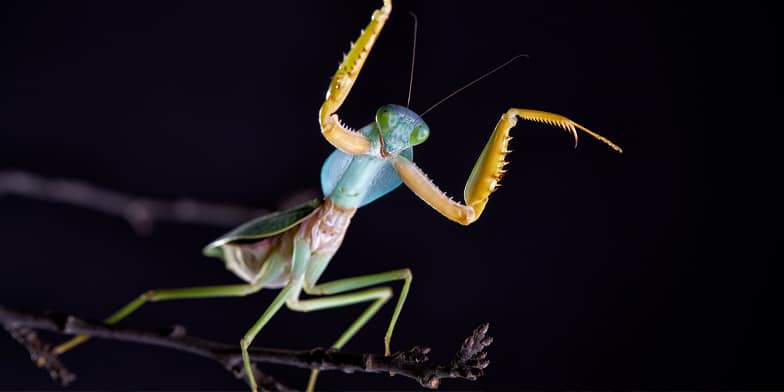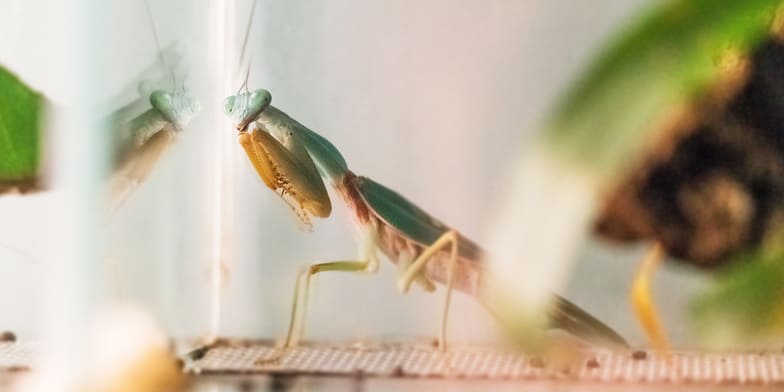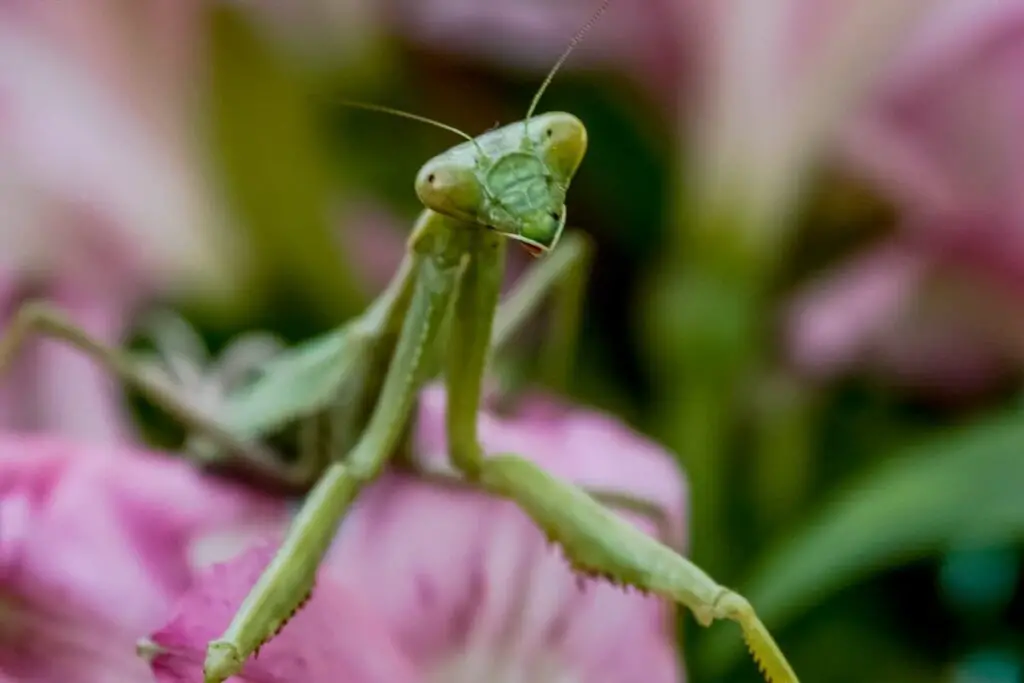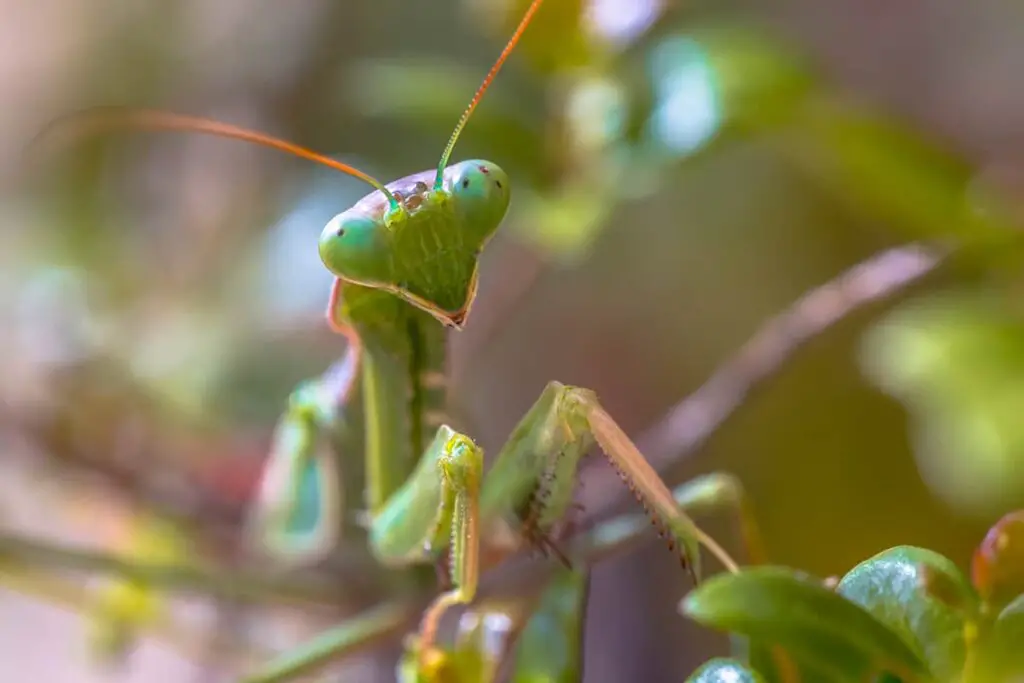
Praying mantises are fascinating creatures, and one of the things that makes them so interesting is the way they move. If you’ve ever watched a praying mantis you may have noticed that they often sway side to side. While it may look like they’re just enjoying a lazy afternoon, there’s actually a good reason for this behavior.
Praying mantis sway side to side to camouflage their appearance and blend into their surroundings while hunting or hiding from predators, to better observe their environment, to support their balance, as part of their mating ritual, and during the molting process.
In this article, we’ll explore why praying mantises sway from side to side and what purpose it serves them, as well as things to look out for when keeping them as pets.
Reasons Why Praying Mantis Sway Side to Side
Praying mantises are very intelligent little insects, and they are well-known for their unusual habit of swaying side to side. But why do they do this? There are actually a few reasons why praying mantises sway side to side:
Swaying Assists With Camouflage
The praying mantis is a master of camouflage. To avoid being seen by predators, they often sway back and forth, making it look like they’re just another leaf or blade of grass blowing in the wind.
During the day, the praying mantis will stay still and rely on camouflage to keep hidden from predators. When night falls, the praying mantis will be more active, using their long legs to sway back and forth. This movement helps the praying mantis stay hidden in the darkness and avoid becoming prey.
The praying mantis is also a cunning predator. It uses its swaying motion to disorient its prey, making it hard for them to identify the threat. This gives the mantis the perfect opportunity to strike.
Swaying Helps Praying Mantis Better Observe Their World
Praying mantises are curious creatures, and they are always on the lookout for prey. To better observe their surroundings, they often sway from side to side. This helps them to gauge distances more accurately, as their depth perception is based largely on movement.
While their vision is not as sharp as ours, they make up for it by using something called motion parallax. This is when nearby objects appear to move more quickly than distant objects. By constantly moving their heads and bodies, praying mantises are able to get a better sense of how far away something is.
Swaying Is Part of the Mating Process
By swaying, the male mantis is able to assess the size and condition of the female, which helps him to gauge her suitability as a mate. If she is too small or in poor condition, he may move on to another potential mate.
In addition, the male mantis can use his vantage point to assess the female’s physical condition. If she is sick or injured, it is likely that she will not be able to produce healthy babies. If she meets his standards, he will continue with the courtship ritual, which eventually leads to mating.
Males of some species of mantis may also dance to attract a mate. This usually involves moving their abdomens up and down or from side to side.
Swaying Can Help Maintain Balance
With its long, thin legs, a mantis can sometimes have trouble maintaining its footing on uneven surfaces. This is where the swaying can help keep them balanced.
When a mantis is resting on a branch or twig, the slightest gust of wind can cause it to lose its footing. By constantly moving back and forth, the mantis can make small adjustments to its position and stay firmly rooted to its perch.
Similarly, during mating, the male mantis must stay balanced on the female’s back. If he falls off, the mating process will be interrupted, and he may not get another chance to mate. By swaying side to side, the male mantis can keep his balance and successfully complete the mating ritual.
Swaying Supports Molting
Before a praying mantis molts it will often sway back and forth as if it is praying. This helps to loosen the old exoskeleton so that the mantis can emerge from it more easily. During molting, (a process also called ecdysis) the mantis will shed its old exoskeleton and emerge into a new, larger one.
After molting, the mantis will be weaker and more vulnerable until its new exoskeleton hardens. During this time, the mantis will sway to stay camouflaged and safe. Once the new exoskeleton has hardened, the mantis will be stronger and more protected from predators.
Why Is My Pet Praying Mantis Swaying?
While a pet praying mantis is relatively protected from danger in the habitat you create for them, they will still instinctively sway. It is important to keep an eye on your pet mantis and make sure that they are behaving normally. If you notice your mantis swaying more than usual, it could be a sign that something is wrong. Here are some things to consider.

Your Mantis Could Be Stressed
You may notice your pet mantis swaying more when you first bring them home, as they adjust to their new surroundings. Once they have settled in, the frequency of their swaying should decrease. While it may look like they’re dancing, it may be that they’re under a lot of stress.
When a mantis feels threatened, they will start to sway back and forth in an attempt to make themselves appear larger and more intimidating. This behaviour is known as displacement activity, and it’s usually a sign that the mantis is feeling overwhelmed. If you see your pet mantis swaying, it’s best to give them some space and let them calm down on their own.
Your Habitat Isn’t Right
Check the temperature and humidity of their habitat, as extreme conditions can cause stress. The ideal temperature for a pet mantis is between 22-26 degrees Celsius (72-78 degrees Fahrenheit), and the humidity should be around 40-60%.
If the temperature or humidity levels are too high or low, it can cause your mantis to become stressed, which may lead to them swaying. Make sure to keep an eye on the conditions in their habitat, and adjust as needed to create a comfortable environment for your pet.
Your Mantis Could Be Sick Or Injured
If you notice your pet mantis swaying more than usual and they don’t seem to be improving, it’s best to take them to the vet. If you are concerned about your pet mantis, it is always best to consult a professional. They will be able to help you diagnose the problem and find a solution.
How Do Praying Mantis Sway?
Praying mantises are unique creatures, and one of the things that makes them so interesting is the way they move their abdomens from side to side. This movement is produced by a special muscle that is attached to the mantis’ exoskeleton. When this muscle contracts, it bends the abdomen to one side, causing the mantis to sway.
They also walk in a very unique way. While most insects simply move their legs forward and backwards, mantises also rock back and forth as they walk. This creates a swaying movement that helps them to maintain their balance and blend in with their surroundings.
Conclusion
Praying mantises are fascinating creatures, and although sometimes we may not be able to discern why they sway from side to side, it’s always obvious they’re doing it for a reason. Whether they’re trying to stay camouflaged, get a better view, or just trying to keep their balance, the praying mantis uses this movement to help them survive in the wild.
When keeping a pet praying mantis it’s important to create a comfortable habitat and watch for signs of stress. If your pet mantis starts swaying more than usual, it could be a sign that something is wrong. Understanding why your pet mantis sways can help you create a better environment for them and keep them healthy and happy.
Driven by a passion for those tiny creatures that rule our world, we at Bug Domain strive to be your go-to resource for information on insects.



